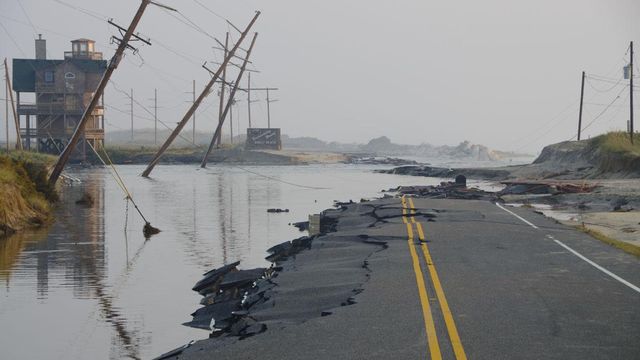Long-term solution for NC 12 elusive
State transportation engineers have a week to devise a plan to get traffic flowing again quickly on Hatteras Island, where the sole overland link to the mainland was severed by Hurricane Irene. Finding a more permanent traffic solution for N.C. Highway 12 will be more problematic, however.
Posted — UpdatedFinding a more permanent traffic solution for N.C. Highway 12 will be more problematic, however.
Irene ripped two gaping holes in N.C. 12 – one in the Pea Island National Wildlife Refuge and the other one north of Rodanthe – and the ocean now rushes through new inlets at both locations.
"I really don't think there's a permanent solution in a situation like this," Billy Edge, a North Carolina State University professor who specializes in coastal engineering, said Wednesday.
Building on a constantly shifting island is a huge challenge, Edge said. Filling in the areas that washed out with new sand and rebuilding the highway could simply lead to another washout.
"The inlet either fills in or maybe it expands, and if it expands, (a) bridge wouldn't be adequate," he said.
The state Department of Transportation has already rejected building a long bridge to the island that would bypass the Pea Island refuge but cost more than $1 billion.
Some have suggested turning N.C. 12 into a toll road, so that people who travel to Hatteras Island would pay for its construction and maintenance. Others have called for scrapping the road altogether and ramping up a ferry system to serve all parts of the island.
Residents like Don Bowers, who lives in Frisco at the southern end of the island, said relying solely on ferries would not only complicate mass evacuations, it also would keep tourists away.
"I think a ferry system would economically just ruin this place," Bowers said. "People just wouldn't be able to make a living down here."
Edge suggested moving N.C. 12 in some places and raising the road.
"Make it higher, and in the process, we bring in material that's resistant to erosion," he said.
That solution also would be expensive, and any hardened structure conflicts with the natural processes of Hatteras. Any long-term plan would have to meet guidelines set forth in an environmental impact study.
Orrin Pilkey, the James B. Duke Professor Emeritus of Geology Earth & Ocean Sciences at Duke University, said N.C. 12 must be moved to correspond to natural shifts in Hatteras Island. The cost of maintaining the highway as is will become too expensive, he said.
"They must move it or lose it," Pilkey said. "Some imagination and creativity is going to be required."
Like the moving sand, finding balance between economic and environmental interests remains elusive.
"To balance those two is something I can't do. That's why we pay politicians," Edge said.
• Credits
Copyright 2024 by Capitol Broadcasting Company. All rights reserved. This material may not be published, broadcast, rewritten or redistributed.





